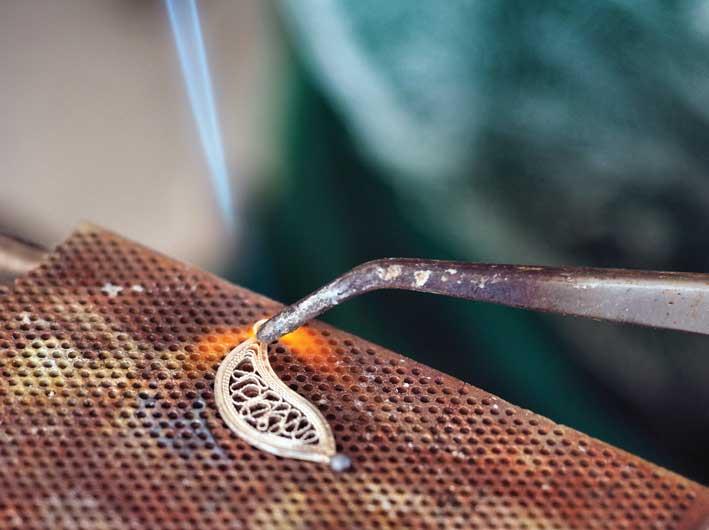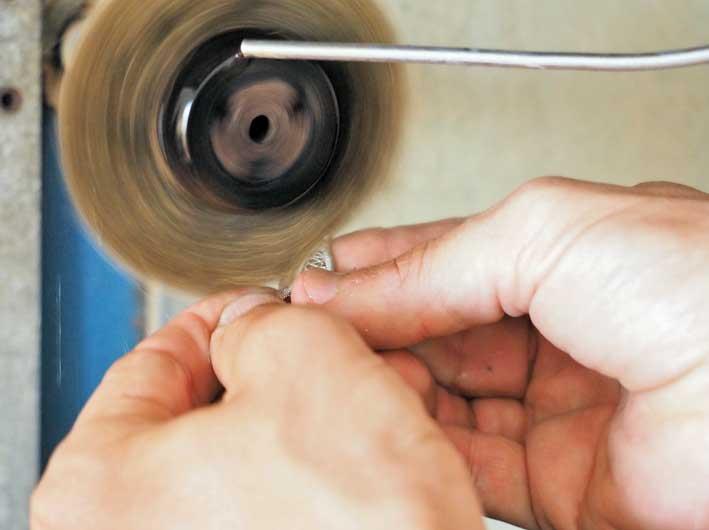Filigree is an art form that dates back over three millennia, an artisanal skill that has somehow managed to transcend national boundaries and was - and still is - practiced primarily in Europe and Asia.
Locally, the work carried out by goldsmiths and silversmiths is a trade regulated by Maltese legislation dating back almost a century that states who is authorised to carry out this kind of activity. Filigree itself, in this respect, is identified by name and carries with it a tradition that has been passed down through countless generations.
It would be perfectly understandable to think that filigree is a traditional Maltese style of jewellery. The sight of a glistening filigree eight-pointed cross made of pristine white silver in the window of any jewellery shop in Malta is practically standard. The reality is, however, that filigree is far from being an indigenous Maltese creation.
Filigree originated in Mesopotamia - or modern-day Iraq, Syria and Kuwait. Attempting to identify the country that is most closely associated with this style of jewellery is particularly difficult, although practitioners will tell you that they have seen some amazing creations coming out of Portugal and Russia - and that's as much as they'll commit themselves to. Despite filigree not being Maltese, there are some amazingly talented filigree artists locally and I've had the privilege this month of talking to one of them - Kevin Attard.

In an old townhouse in Gzira, with floors of traditional handmade patterned Maltese tiles, in a small, well-lit room on the roof, is Kevin's workshop. Sporting a pair of Crocs, he greets me with a smile and pulling out a chair from behind the work bench, offers it to me. Pruxka the cat (the favourite out of his five cats) walks cautiously into the room to approve of the new guest and jumps onto Kevin's lap.»
«We immediately start chatting. Kevin is currently training to complete a triple ironman challenge - a triathlon that lasts over 50 hours. The discipline, patience and concentration required to work filigree are values that certainly come in handy when undertaking such a gruelling daily training regime. It becomes immediately apparent that Kevin enjoys a good challenge. He has participated in the "Premju Ġieħ l-Artiġjanat Malti" competition four times and has been among the winners every time.
Hailing from a family of jewellers, Kevin started working filigree at the age of 14. It was when his father first introduced him to Raymond Falzon, who decided to take him under his wing, that he realised how low his standards were at the time. Over 20 years have passed since then and it can be said with confidence that the quality, innovation and thought that Kevin brings to his work have made his pieces trend-setters on the local scene.
The world of filigree-makers in Malta is an interesting one. Although there is a growing demand for filigree, the number of registered filigree artists has dwindled over the years, with only about six full-time practitioners still working today.
The competition amongst these craftsmen can be fierce at times, with one exception. I am told that there is a 'king of filigree' in Malta - who manages to work effectively with all of them, irrespective of whether they are competitors or not - a certain Gaetano Saliba, who plays an important role in keeping the filigree tradition alive here.
Kevin tells me that there is a growing amount of foreign filigree entering the local market to cater for the public's demand, which is inherently not a bad thing because the quality and craftsmanship of these pieces can be extremely good. The only issue is when these imported items are erroneously labelled as 'Made in Malta'.

Interestingly enough, Kevin attributes his rise into experimenting with new designs and techniques partly to the competition brought about with the introduction of foreign pieces. His award-winning creations so far include a life-size filigree violin and skull, a neck piece and even a miniature toilet. Each of these pieces took months to complete, with some even representing a year of work.
When I inquire what is involved in creating an item of filigree, he gives me a quick demonstration by making a small pendant in less than five minutes. He then brings out his 'hallmarker', a microscopic stamp bearing his signature, and marks the piece.
Telling me that he only listens to Italian radio while he works, Kevin then explains that the first step is to make a form out of silver thread composed of 925 grams of silver and 25 grams of copper (for added strength) and he then starts filling it in with 'rizzoli' wire, a super-fine silver thread composed of 1000-gram silver, woven into a plait.
Methodically and meticulously twisting the thread into the desired shape, Kevin's fingers seem to move almost mechanically with precision - a necessity when working with such a fine, delicate medium. He peppers the unfinished pendant with borax, a chemical stimulant that activates and facilitates the bond when heated. The final step is an acid wash to remove the impurities from the soldering process and to bring out the silver's unmistakable colour.
Kevin tells me that he has three major ideas for the near future: the first is to start using gold-plated filigree in his work, the second is to make another filigree skull (which he describes as his most enjoyable and challenging piece of work so far) but this time using gold thread, and the third, and most ambitious is to one day make a full-length, wearable, curvaceous dress out of filigree.
Anyone interested in learning more about filigree can contact Kevin on 9930 9249 to participate in a small group session where between one to four participants can learn to make their own pendant - in itself an interesting gift. For more serious students, Kevin takes on no more than two people for a year-long course intended to introduce participants to the basic skills needed to begin developing their own technique.